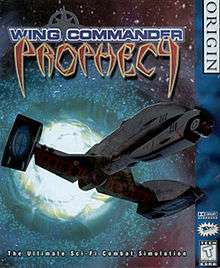Wing Commander: Prophecy
| Wing Commander: Prophecy | |
|---|---|
 | |
| Developer(s) |
Origin Systems Raylight Studios (GBA) |
| Publisher(s) |
Electronic Arts Destination Software (GBA) |
| Director(s) | Frank Roan |
| Producer(s) |
David Downing Mark Day |
| Designer(s) | Billy Joe Cain |
| Programmer(s) | Peter Shelus |
| Artist(s) | Mark Vearrier |
| Writer(s) |
David Carren J. Larry Carroll |
| Composer(s) |
George Oldziey Bill Munyon |
| Series |
Wing Commander |
| Platform(s) | Windows, Game Boy Advance |
| Release |
Windows Game Boy Advance |
| Genre(s) | Space combat simulation |
| Mode(s) |
Single-player Multiplayer (GBA only) |
Wing Commander: Prophecy is the fifth installment in the Wing Commander science fiction space combat simulator franchise of computer games. The game was released in 1997, produced by Origin Systems and Italy-based Raylight Studios for the GBA, and distributed by Electronic Arts.
The game features a new game engine (the VISION Engine), new spacecraft, characters and story elements. The events depicted in Prophecy are set over a decade after Wing Commander IV: The Price of Freedom and, rather than the Kilrathi, the player must deal with a new alien threat, an insectoid race codenamed Nephilim that has invaded the human galaxy through a wormhole. Prophecy was the first main-line Wing Commander game in which the player did not take on the role of Christopher Blair, instead being introduced to a new player character, Lance Casey. Some of the characters and actors from previous games return in Prophecy, where they rub elbows with an entirely new cast of Confederation pilots and personnel.
A standalone expansion pack, Secret Operations, was released by Origin in 1998 solely over the Internet and for no charge. The large initial file challenged the dial-up connections of that day. Secret Operations was later released for sale in combination with Prophecy in the Wing Commander: Prophecy – Gold package. A Game Boy Advance port of Prophecy with added multiplayer was released in 2003.
Gameplay
Controls are available in two modes: basic, catering for new and casual players, and advanced, aiming to give a more realistic feeling of space combat. The two modes leverage the same flight dynamics engine but in basic mode turning the ship around is assisting the player by coupling pitch, yaw, and roll (emulating airplane flight dynamics), while in advanced mode each axis is made independent for more complex but increased control, especially when using a HOTAS setup. There is also the possibility to temporarily disable the coupling system that assists the player in keeping thrust forward as the player pivots along the axes as if the spacecraft was an airplane: when this assisting system is disabled it is therefore possible to tilt the spacecraft using thrusters while keeping movement constant through inertia, as is realistic in space, and allowing for advanced offensive and defensive maneuvers, such as drifting sideways alongside a capital ship while shooting at it or quickly pivoting 180 degrees around and shooting at a chasing fighter.
Missions are played in sequence, and while the core scenario is constant, it is possible to fail missions and keep going forward in the game. Subsequent missions may become increasingly harder as the enemy gains an upper hand on the operational theater. Sidekicks may die in mission, resulting in a KIA in the leaderboard.
Reception
| Reception | ||||||||||||||
|---|---|---|---|---|---|---|---|---|---|---|---|---|---|---|
| ||||||||||||||
PC Data, which tracked computer game sales in the United States, reported that Wing Commander: Prophecy earned $6.7 million and sold roughly 195,000 copies by October 1999. Its revenue in the country represented a drop from Wing Commander IV.[5]
Wing Commander: Prophecy was nominated in the Academy of Interactive Arts & Sciences' first annual Interactive Achievement Awards in the category "Computer Action Game of the Year".[6]
The editors of Computer Games Strategy Plus named Wing Commander: Prophecy the best "Sci-Fi Simulation" of 1997.[7]
References
- ↑ "Wing Commander: Prophecy for PC - GameRankings". Retrieved March 1, 2016.
- ↑ "Wing Commander: Prophecy for Game Boy Advanced - GameRankings". Retrieved March 1, 2016.
- ↑ "Wing Commander: Prophecy for Game Boy Advanced". Retrieved March 1, 2016.
- ↑ "PC Gamer Online". pcgamer.com. Archived from the original on February 26, 2000. Retrieved August 6, 2015.
- ↑ Asher, Mark (October 29, 1999). "Game Spin: Crunching Numbers". CNET Gamecenter. Archived from the original on October 15, 2000.
- ↑ "1998 1st Interactive Achievement Awards". Academy of Interactive Arts & Sciences. 1998. Retrieved December 29, 2011.
- ↑ Staff (January 19, 1998). "The winners of the 1997 Computer Games Awards". Computer Games Strategy Plus. Archived from the original on February 6, 2005.